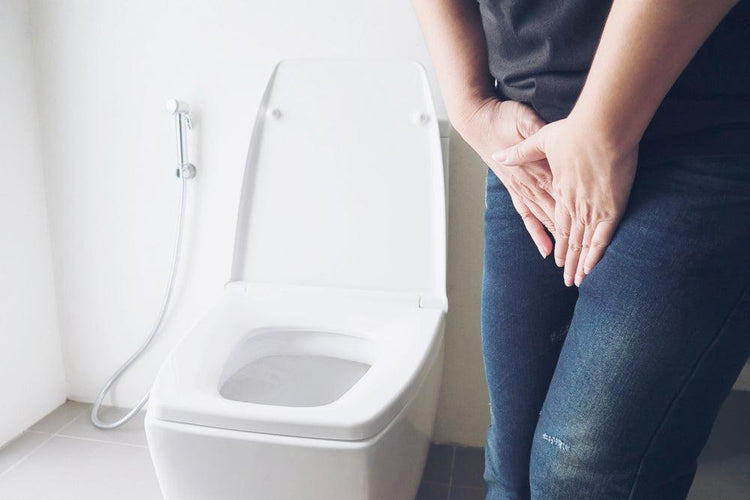Cystitis vs. UTI: Understanding the Differences
Posted on:
Sep 21, 2023
Authored by

×
Related products
Cystitis and UTI: Defining and Understanding the Conditions
Definition and Distinction
Cystitis and urinary tract infections (UTIs) are common conditions affecting the urinary system, but they are not synonymous. Cystitis is a specific type of UTI that occurs in the bladder. It’s characterized by inflammation of the bladder’s lining, typically due to an infection. UTIs, however, can occur in any part of the urinary system, including the urethra, bladder, ureters, and kidneys. While cystitis is a type of UTI, not all UTIs are cystitis.Urinary Tract Infection (UTI)
A UTI is an infection in any part of the urinary system, caused predominantly by bacteria, though fungi and viruses can also be culprits. E. coli, a type of bacteria found in the gastrointestinal tract, is the most common cause. UTIs are categorized as lower (affecting the urethra and bladder) and upper (affecting the ureters and kidneys), with lower UTIs being more common. Symptoms include a burning sensation during urination, frequent urge to urinate, cloudy or strong-smelling urine, and lower abdominal pain.Cystitis
Cystitis specifically refers to inflammation of the bladder, most commonly due to a bacterial infection. However, it can also be caused by certain medications, radiation therapy, or irritants like catheters. It primarily presents with symptoms like pain and discomfort in the lower abdomen, a burning sensation during urination, frequent urination, and cloudy or bloody urine.The Urinary System: A Brief Overview
The urinary system, or urinary tract, is a body system designed to filter out excess fluid and waste products from the bloodstream and eliminate them from the body. It comprises the kidneys, where urine is produced; the ureters, tubes that carry urine from the kidneys to the bladder; the bladder, where urine is stored; and the urethra, through which urine is expelled from the body.Impact of Infections on the Urinary System
Infections like UTIs and cystitis can disrupt the normal functioning of the urinary system. They can cause discomfort, pain, and inflammation and, if left untreated, can lead to serious complications such as kidney infections and sepsis. Bacteria entering the urinary tract can adhere to the walls of the urinary organs, multiply, and cause infection, leading to symptoms like pain, burning, and frequent urination. Understanding the distinction between cystitis and other UTIs is crucial for accurate diagnosis and appropriate treatment. While cystitis is localized to the bladder, UTIs can occur in any part of the urinary system. Both conditions, if left unaddressed, can lead to serious complications, emphasizing the importance of early detection and intervention. The urinary system's principal function is to eliminate waste from the body, and any disruption due to infections necessitates prompt medical attention to maintain overall health.Anatomical Context: Locating Cystitis and UTI in the Urinary System
Anatomical Differences and Manifestation
Cystitis and UTIs manifest in different parts of the urinary system due to their distinct nature. Cystitis is specifically localized to the bladder, resulting in inflammation of the bladder wall, usually due to bacterial infections. In contrast, UTIs can occur in any part of the urinary system, including the urethra, bladder, ureters, and kidneys.The Urinary Tract: A Detailed Exploration
The urinary tract is anatomically divided into the lower and upper urinary tracts. The lower urinary tract consists of the urethra and the bladder. The upper urinary tract includes the ureters and the kidneys. - Lower Urinary Tract: This part is often the initial site of infection. When a UTI is localized in the urethra, it is termed urethritis; when in the bladder, it is referred to as cystitis. - Upper Urinary Tract: If the infection ascends past the bladder and reaches the ureters and kidneys, it is considered an upper UTI. Infections in the ureters are termed ureteritis, and those in the kidneys are called pyelonephritis.Relevance of Lower and Upper UTIs to Cystitis and UTI
Cystitis is a form of lower UTI, specifically affecting the bladder. It is one of the most common manifestations of UTIs and is typically characterized by symptoms like frequent urination, a burning sensation during urination, and lower abdominal discomfort. Upper UTIs like pyelonephritis are usually more severe and may require more intensive treatment as they can potentially lead to kidney damage. Symptoms of upper UTIs may include back pain, fever, and nausea, in addition to the typical symptoms seen in lower UTIs. Understanding the anatomical context in which cystitis and UTIs occur is crucial for accurate diagnosis and effective treatment. While cystitis is a lower UTI affecting the bladder, UTIs can manifest in any component of the urinary system, with those affecting the upper urinary tract generally posing more serious risks. Early recognition of symptoms, appropriate diagnosis, and timely intervention are vital in managing both cystitis and other UTIs to prevent complications and safeguard urinary function.Clinical Manifestations: Discerning the Symptoms of Cystitis and UTIs
Overview of Symptoms
Cystitis and urinary tract infections (UTIs) manifest a spectrum of symptoms that can range from mild to severe. Cystitis typically presents as an infection of the bladder, a component of lower UTIs, while UTIs can also involve the upper tract, including the kidneys, yielding a diverse array of symptoms.Symptoms of Cystitis
- Burning sensation during urination - Increased frequency and urgency of urination - Lower abdominal pain - Cloudy, strong-smelling, or bloody urine - Discomfort or pressure in the lower abdomen - Low-grade feverSymptoms of Upper UTIs (Pyelonephritis)
- High fever and chills - Nausea and vomiting - Upper back and side pain - Extreme fatigueValue of Symptom Differentiation
Recognizing the differences in symptoms between cystitis and upper UTIs is vital for accurate diagnosis and treatment. While both conditions share common symptoms like dysuria and urinary frequency, the presence of systemic symptoms such as high fever and flank pain typically suggests an upper UTI, potentially requiring more aggressive management.Diagnostic Implications
Distinguishing between the two conditions guides the healthcare provider in recommending the appropriate diagnostic tests, such as urinalysis or imaging studies. A correct diagnosis is imperative to determine the suitable treatment approach and antibiotic selection, as mismanagement can lead to complications like renal damage.Treatment Variations
While antibiotics form the cornerstone of treatment for both cystitis and UTIs, the type, duration, and administration might differ depending on the severity and location of the infection. Cystitis may often be managed with a short course of oral antibiotics, whereas upper UTIs might necessitate intravenous antibiotics and a longer treatment duration. The discernment of symptoms between cystitis and UTIs is crucial to ensure accurate diagnosis and optimal treatment. A nuanced understanding of the clinical manifestations aids healthcare providers in implementing the right therapeutic strategies, thus preventing complications and improving patient outcomes. Early recognition and appropriate intervention are pivotal in managing the varied presentations of urinary tract infections.Diagnostic Pathways: Identifying Cystitis and UTIs

Introduction to Diagnostics
Cystitis and UTIs, while exhibiting overlapping symptoms, necessitate distinct diagnostic approaches to ensure accurate identification and treatment. Accurate diagnosis is crucial to delineate between lower UTIs such as cystitis and upper UTIs, which may involve the kidneys and are typically more severe.Initial Assessment
The diagnostic pathway generally begins with a thorough medical history and physical examination, focusing on the presence of hallmark symptoms such as dysuria, urinary frequency, urgency, and lower abdominal discomfort.Urinalysis
Urinalysis is a fundamental test employed to diagnose both cystitis and UTIs. This test examines the urine for signs of infection, such as the presence of white blood cells, red blood cells, and bacteria. It can provide swift and crucial information to confirm a urinary tract infection.Urine Culture
A urine culture may be conducted to identify the specific bacteria causing the infection. This test is essential in guiding the choice of antibiotic therapy, particularly in cases of recurrent infections or when initial treatments fail.Imaging Studies
In cases where upper UTIs are suspected, or when underlying anatomical abnormalities are a concern, imaging studies like ultrasounds or CT scans may be recommended to visualize the urinary tract and assess for abnormalities or obstructions.Cystoscopy
Cystoscopy may be utilized in recurrent or complicated cases to examine the bladder’s interior, identify abnormalities, and obtain tissue samples for further analysis.Importance of Differential Diagnosis
Differential diagnosis is vital to distinguish between cystitis and more severe upper UTIs, allowing for targeted treatment strategies. It is also crucial to rule out other conditions with similar symptomatology such as interstitial cystitis, bladder tumors, or stones, ensuring the underlying cause of symptoms is accurately addressed.Consideration of Risk Factors
Evaluating patient history for risk factors like sexual activity, urinary tract abnormalities, and use of certain types of birth control can aid in diagnosis and subsequent management of urinary tract infections. Employing an array of diagnostic tools is indispensable for accurately identifying cystitis and UTIs. A precise diagnosis enables the implementation of effective treatment strategies, thereby reducing the risk of complications and recurrence. Differential diagnosis plays a pivotal role in distinguishing between different urinary tract conditions and is essential in tailoring treatment to the patient’s specific needs. Balancing clinical judgment with diagnostic findings is crucial in the management of these prevalent conditions, ultimately aiding in the restoration of urinary health and patient well-being.Treatment Alternatives: Addressing Cystitis and UTIs
Introduction to Treatment
Treatment for cystitis and UTIs is predominantly centered on antibiotics, but the choice of antibiotic and the duration of treatment can vary significantly between the conditions. Accompanying measures, including pain management and lifestyle modifications, can also play essential roles in managing symptoms and preventing recurrence.Antibiotic Therapy
Antibiotic treatment is the mainstay for both cystitis and UTIs. The choice of antibiotic is crucial and is typically guided by the sensitivity pattern observed in urine cultures. For cystitis, shorter courses of antibiotics like nitrofurantoin or trimethoprim/sulfamethoxazole are usually effective. UTIs, especially those involving the kidneys, may necessitate longer courses and sometimes intravenous administration of antibiotics such as ceftriaxone.Preferred Antibiotics
The preferred antibiotics for uncomplicated cystitis are nitrofurantoin and trimethoprim/sulfamethoxazole. Fosfomycin is another option, particularly suitable for single-dose treatment. For more complicated or severe UTIs, fluoroquinolones, beta-lactams, or aminoglycosides may be required, depending on the identified pathogen and its antibiotic susceptibility.Adjunctive Interventions
Beyond antibiotics, symptomatic relief is vital. Analgesics like phenazopyridine can alleviate pain and discomfort associated with these conditions. Additionally, adequate hydration can aid in flushing out bacteria from the urinary tract, while avoiding irritants like caffeine and spicy foods can minimize discomfort.Lifestyle and Behavioral Modifications
Lifestyle adjustments, including voiding regularly, fully emptying the bladder, and maintaining good personal hygiene, are pivotal in managing and preventing cystitis and UTIs. Post-coital voiding and cranberry products may be recommended for those with recurrent infections, particularly sexually active women.Alternative Therapies
Probiotics and immune enhancers are explored as adjuncts or alternatives to antibiotics, with the aim to restore a healthy urinary environment and enhance the body’s natural defenses against infections. However, the efficacy of such interventions requires further validation through extensive research.Preventing Recurrence
For those prone to recurrent infections, a more proactive approach involving prophylactic antibiotics, self-start therapy, and regular monitoring is essential. A focus on prevention through lifestyle modifications and possible interventions to correct anatomical predispositions is also crucial. Cystitis and UTIs, while related, necessitate tailored treatment strategies to effectively address the differing extent and location of infection. A harmonious integration of antibiotic therapy, symptomatic relief, lifestyle modifications, and preventive measures is essential for comprehensive management. The exploration of alternative therapies and preventive strategies is crucial to address the growing concern of antibiotic resistance and to provide sustainable solutions for those dealing with recurrent infections. Ultimately, patient education and adherence to prescribed treatments are fundamental in achieving optimal outcomes and enhancing urinary health.Preventive Measures: Proactive Strategies to Thwart Cystitis and UTIs
Introduction to Prevention
Preventing cystitis and UTIs is fundamentally linked to lifestyle choices and personal hygiene practices. A proactive approach can significantly reduce the incidence of these infections, alleviating the discomfort and health risks associated with them.Hydration is Key
Maintaining optimal fluid intake is crucial to flush out bacteria from the urinary system, minimizing the risk of infections. Water is the preferred choice, and individuals are generally advised to consume around eight 8-ounce glasses of water a day, or approximately 2 liters, and to avoid excessive intake of irritants like caffeine and alcohol.Regular and Complete Voiding
Regular urination helps in expelling bacteria from the urinary tract, reducing the chance of infection. Avoiding holding urine and ensuring the bladder is fully emptied can help in preventing bacterial growth and subsequent infection.Good Personal Hygiene
Maintaining cleanliness in the genital area is vital. It's advised to wipe from front to back after using the toilet to prevent bacteria from the anal area from spreading to the urethra. Additionally, washing the genital area daily and before and after sexual activity can reduce bacteria accumulation.Lifestyle Modifications
Adopting healthier lifestyle choices, such as wearing breathable cotton underwear, avoiding irritating feminine products, and opting for showers over baths, can minimize the risk of infections. Post-coital urination can also help in flushing out any bacteria that may have entered the urethra during intercourse.Dietary Considerations
A balanced diet supports overall health, including the immune system’s ability to fend off infections. Some studies suggest that cranberry products might prevent UTIs by preventing bacteria from adhering to the urinary tract walls. Probiotics can also help in maintaining a healthy balance of bacteria in the body.Regular Medical Check-ups
Regular medical screenings and urine tests can detect any abnormalities or infections in the early stages, enabling timely intervention. This is especially important for those with risk factors like urinary tract abnormalities or weakened immune systems. Prevention of cystitis and UTIs involves a multifaceted approach centered around maintaining hydration, practicing good personal hygiene, making thoughtful lifestyle choices, and seeking regular medical advice. Incorporating these preventive measures can significantly reduce the likelihood of developing these uncomfortable and potentially serious conditions, promoting urinary tract health and overall well-being. While individual susceptibility can vary, adhering to these practices optimizes the body’s defenses against urinary infections and contributes to long-term health.Complication and Prognosis: Consequences of Neglecting Cystitis and UTIs
Untreated Implications
Cystitis and UTIs, if left untreated, can escalate to severe conditions affecting both the lower and upper urinary tract and may lead to systemic complications. Early detection and proper management are crucial to avoid irreversible damage and ensure a favorable prognosis.Ascension of Infection
Untreated UTIs can ascend from the lower urinary tract to the kidneys, leading to pyelonephritis, a severe kidney infection. This can cause permanent kidney damage and can be life-threatening if bacteria enter the bloodstream, leading to sepsis, which requires immediate medical attention.Recurrent Infections
Failure to adequately treat cystitis and UTIs can result in recurrent infections, causing a cycle of inflammation and discomfort. Chronic UTIs may require a more prolonged and aggressive approach to treatment, such as long-term low-dose antibiotics.Urinary Retention
Unaddressed UTIs may lead to urinary retention due to swelling and inflammation, requiring catheterization to relieve. This condition is painful and can lead to bladder and kidney damage if not addressed promptly.Urethral Narrowing
In men, neglected UTIs can result in urethral stricture, a narrowing of the urethra due to scarring, making urination difficult and painful, and potentially leading to urinary retention and bladder damage.Long-term Prognosis
While most UTIs and cases of cystitis respond well to treatment, delays in addressing these conditions can lead to poor outcomes. Long-term complications may include chronic kidney disease, heightened vulnerability to subsequent infections, and, in severe cases, renal failure or sepsis.Impact on Quality of Life
Chronic or recurrent infections can significantly affect one’s quality of life, leading to ongoing discomfort, frequent doctor visits, and a continual need for medication, impacting daily activities and mental well-being. Timely diagnosis and adequate treatment of cystitis and UTIs are crucial to prevent complications and ensure a good prognosis. Neglecting symptoms can lead to severe, irreversible damage and can be life-threatening in extreme cases. Individuals experiencing symptoms should seek medical advice promptly to initiate appropriate treatment and management strategies, thereby mitigating risks and enhancing the quality of life. Regular medical check-ups, early intervention, and adherence to prescribed treatment regimens are essential components in managing these conditions and preventing long-term complications.Patient Perspectives: Navigating the Challenges of Cystitis and UTIs









 Rated Excellent by 26,523+ Reviews
Rated Excellent by 26,523+ Reviews